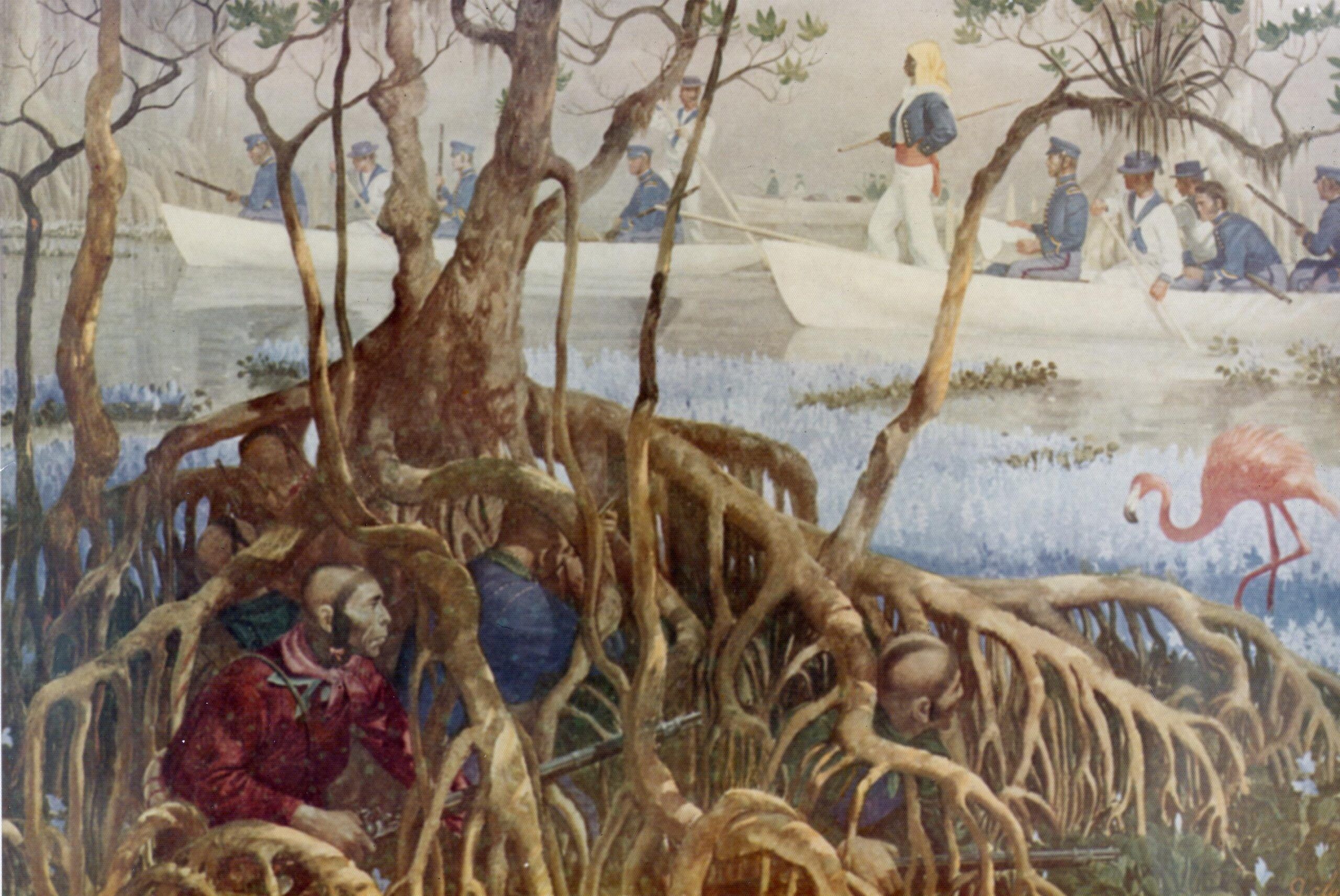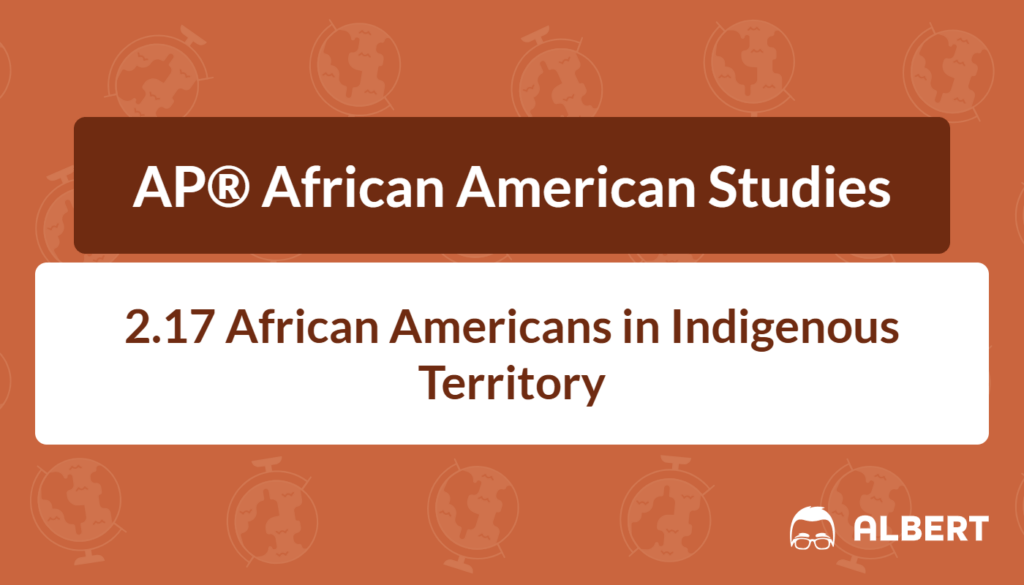What We Review
Introduction
African Americans who escaped to and lived in Indigenous territory is a topic often overlooked. However, it provides crucial insights into the fabric of American history. African Americans and Indigenous people experienced both kinship and conflict. Moreover, the institution of slavery played a key role in shaping their interactions. Understanding these relationships helps explain how different communities navigated the long war over land and freedom.
This study guide explores themes such as enslavement, daily life, and survival strategies in Indigenous lands. It also highlights how African Americans managed to thrive and resist oppression under challenging circumstances. Therefore, students can use this guide to gain clarity on African American and Indigenous alliances, tensions, and shared experiences—essential elements for AP® African American Studies.
Historical Context
The story begins in the southeastern region of what is now the United States. Indigenous nations like the Seminole, Cherokee, Choctaw, Chickasaw, and Muscogee (also known as Creek) lived in these rich lands. However, the arrival of European settlers led to dramatic changes. Over time, forced assimilation, wars, and displacement transformed Indigenous societies.
The Setting
- African Americans arrived in these lands either through forced migration or as runaway slaves seeking refuge.
- Relations between Black and Indigenous peoples ranged from cooperation and intermarriage to enslavement and conflict.
- Slavery’s expansion in the southern United States had a major impact, pushing some African Americans deeper into Indigenous territory in search of better opportunities—or basic survival.
This background sets the stage for understanding how alliances, such as the one between African Americans and the Seminoles, emerged. Therefore, learning about this period gives students a clearer view of the complexity of early American history.
The Impact of Slavery on Black and Indigenous Relations
When slavery expanded in the South, both unity and division grew among African American and Indigenous communities. African Americans who fled plantations often found refuge in remote regions where Indigenous nations resided. However, Indigenous leaders sometimes held slaves themselves, which created tension.
Mutual Support and Conflict
- Mutual Support: Some African Americans, known as maroons, found safe haven among the Seminoles in Florida. These individuals learned local languages and customs, blending into Indigenous communities.
- Conflict: Other Indigenous groups, especially the five large nations, used slave labor and replicated some European laws. Therefore, these practices put overwhelming pressure on African Americans seeking freedom.
Thus, slavery’s growth could encourage shared defense against common enemies or fuel disagreements over land and resources. In either case, the institution of slavery shaped social, economic, and political ties between Black and Indigenous peoples.
The Black Seminoles
The Black Seminoles—African Americans who lived alongside the Seminole Nation—offer one of the best examples of entwined histories. They formed deep bonds, marrying into Seminole families and acting as interpreters, advisors, and warriors.
Origins and the Second Seminole War
- Origins: The Black Seminoles emerged as runaway slaves joined Seminole communities. Over time, they created a tightly knit group with shared cultural practices.
- The Long War: Known as the Second Seminole War (1835–1842), it was one of the longest and costliest wars for the U.S. against Indigenous nations. The Black Seminoles fought fiercely alongside the Seminoles to preserve their freedom.
- Resistance in Action:
- Flee: Enslaved Africans escaped plantations and ventured into Seminole territory.
- Adapt: They learned the Seminole language and built homesteads.
- Ally: Both groups resisted U.S. forces through guerrilla tactics.
- Survive: Even after capture or forced removal, Black Seminoles continued to advocate for communal protection.
The bravery shown by the Black Seminoles made them iconic defenders of freedom. Therefore, their story highlights determination in the face of incredible hardships.

Maroons and Their Refuge
Maroons were African Americans who escaped slavery and established self-sustaining communities. These communities often thrived in swamps or densely wooded areas, providing natural defenses against slave catchers.
Definition and Background
- The term “maroons” refers to freedom seekers who banded together in hidden settlements, sometimes in cooperation with local Indigenous tribes.
- Indigenous nations offered new arrivals protection and land in exchange for labor or military support.
- Over time, these maroon communities became centers of African American culture, combining African traditions with Indigenous customs.
Notable Maroon Communities
- The Great Dismal Swamp: Located between Virginia and North Carolina, it sheltered numerous maroons for decades.
- Maroon Settlements in Florida: These communities often connected with the Seminoles, leading to strong alliances in battles against U.S. forces.
By forming these networks, maroons demonstrated collective strength and resilience. In turn, their unified stand influenced future movements for freedom.
Enslavement within Indigenous Nations
While some Indigenous peoples offered protection to African Americans, others institutionalized slavery. Several communities in the five large nations enslaved African Americans. They sometimes imitated European-style slave codes.
Role of African Americans Among Five Large Indigenous Nations
- Household Labor: Enslaved individuals often worked in the homes of Indigenous slaveholders.
- Agricultural Work: Many cultivated fields within Indigenous territory.
- Family Ties: In some cases, African Americans married into Indigenous families, leading to mixed-race descendants.
The Trail of Tears
The forced relocation called the Trail of Tears occurred from the 1830s to the 1840s. During this journey, Indigenous slaveholders took African Americans with them to new lands in present-day Oklahoma. Therefore, slavery’s footprint extended beyond the southeastern states, forever shaping those relocated communities.
The Trail of Tears and Its Impact on Enslaved People
During the 1830s, the U.S. government forcibly removed the Five Civilized Tribes—Cherokee, Creek, Chickasaw, Choctaw, and Seminole—from their ancestral lands in the Southeastern United States. This mass displacement, known as the Trail of Tears, was part of a broader policy of Indian Removal that prioritized white settlement and expansion over Native sovereignty.
Often overlooked is the fact that many Native nations held enslaved African Americans, who were also forced to travel west alongside their enslavers. These individuals had no agency in the matter and endured the same brutal conditions: freezing temperatures, disease, starvation, and exhaustion. Many did not survive the journey.
Once relocated to unfamiliar territory west of the Mississippi River, enslaved people faced the daunting task of rebuilding lives under continued bondage. They were expected to clear land, cultivate new crops, and help reestablish plantations for their enslavers—this time in Indian Territory. Despite these hardships, enslaved people preserved cultural traditions and found ways to resist oppression in their new environment, continuing the broader story of survival and resistance throughout American history.
This pattern of displacement and forced labor set the stage for complex racial and cultural identities in the decades that followed.
Codification of Racial Slavery
Indigenous communities adapted certain European legal frameworks by introducing slave codes that regulated ownership, movement, and punishment of enslaved individuals. Over time, such legal practices solidified racial differences within these societies.
Slave Codes and Patrols
- Slave Codes: Modeled after U.S. laws, these codes spelled out the rights Indigenous enslavers held over African Americans.
- Patrols: Responsible for capturing runaway slaves, these groups worked with U.S. authorities, thereby eliminating safe havens for freedom seekers.
Consequences for Kinship Ties
- Hardening Racial Lines: Codified slavery treated Africans and their descendants as outsiders, even within long-standing kinship networks.
- Declining Mixed-Race Recognition: Individuals of African and Indigenous heritage faced exclusion from tribal memberships, losing cultural identity and property rights.
Example
Consider a mixed-race individual recognized as a tribal member before the codes took effect. After codification, that person might lose legal status, land claims, or even freedom. Therefore, these laws had harsh, long-term consequences for Black–Indigenous families.
Required Sources and Their Significance
Primary sources shine light on how African Americans navigated life within Indigenous nations:
1. Diary Entry Recounting the Capture of 41 Black Seminoles by Gen. Thomas Sidney Jesup (1836)
- Provides firsthand evidence of Black Seminoles’ plight during the Second Seminole War.
- Reveals the U.S. military’s strategies and highlights the desperation faced by freedom seekers.
2. Gopher John, a Black Seminole Leader and Interpreter (1863)
- Shows how individuals with African and Seminole heritage served as cultural bridges and negotiators.
- Emphasizes the continued struggle for autonomy even after relocation.
3. Arkansas Petition for Freedmen’s Rights (1869)
- Demonstrates post–Civil War dynamics among African Americans in Indigenous territories.
- Calls attention to evolving legal requests for economic and social rights.
4. Abraham, a Black Seminole Leader (1863)
- Shows another key Black Seminole figure who advocated for self-governance and set an example of leadership.
- Reflects deeper discussions of identity, community, and mutual respect.
Each source highlights a different angle of African American life under Indigenous governance. Collectively, they confirm both the opportunities and challenges that defined these experiences.
Conclusion
African Americans in Indigenous territory endured slavery’s reach, but they also forged partnerships that helped them endure and resist. The Black Seminoles, in particular, exemplified this unity, while maroon communities demonstrated the power of collective self-determination. However, the adoption of slave codes within Indigenous nations and forced removals, like the Trail of Tears, reveal the unevenness of these relationships.
These stories remind students that American history is multifaceted. Therefore, recognizing the struggles and alliances that shaped these communities is crucial for understanding broader themes of resistance, identity, and community building. This perspective enriches any examination of slavery, freedom, and cultural exchange in AP® African American Studies.
Quick Reference Vocabulary Chart
| Term | Definition |
| Maroons | Enslaved individuals who escaped and formed free communities, often in remote areas. |
| Black Seminoles | African Americans associated with the Seminole Nation, known for alliances in resisting U.S. forces. |
| Slave Codes | Laws that defined the status and rights of enslaved people, restricting their movements and freedoms. |
| Trail of Tears | The forced relocation of Indigenous nations, leading to widespread suffering and death. |
Sharpen Your Skills for AP® African American Studies
Are you preparing for the AP® African American Studies test? We’ve got you covered! Try our review articles designed to help you confidently tackle real-world AP® African American Studies problems. You’ll find everything you need to succeed, from quick tips to detailed strategies. Start exploring now!
Need help preparing for your AP® African American Studies exam?
Albert has hundreds of AP® African American Studies practice questions, free response, and full-length practice tests to try out.









